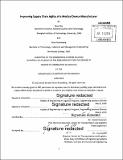| dc.contributor.advisor | Daniel Steeneck. | en_US |
| dc.contributor.author | Bai, Xinye | en_US |
| dc.contributor.author | Rosenberg, Yaniv | en_US |
| dc.contributor.other | Massachusetts Institute of Technology. Engineering Systems Division. | en_US |
| dc.date.accessioned | 2015-11-09T19:49:49Z | |
| dc.date.available | 2015-11-09T19:49:49Z | |
| dc.date.copyright | 2015 | en_US |
| dc.date.issued | 2015 | en_US |
| dc.identifier.uri | http://hdl.handle.net/1721.1/99802 | |
| dc.description | Thesis: M. Eng. in Logistics, Massachusetts Institute of Technology, Engineering Systems Division, 2015. | en_US |
| dc.description | Cataloged from PDF version of thesis. | en_US |
| dc.description | Includes bibliographical references (pages 68-69). | en_US |
| dc.description.abstract | This thesis focuses on a medical device manufacturer, DeCo, which offers surgical instruments to customers at no cost in order to facilitate the sale of implantable products that require the use of such instruments. DeCo is facing challenges in managing the supply chain for these outsourced instruments, such as long lead times, inaccurate forecasting, and excess inventory. Deco is interested in building a more responsive supply chain. To this end, our thesis investigated strategies to increase the supply chain agility by realizing opportunities in information flows, material movement, and channel alignment to achieve shorter lead time, lower inventory levels, and higher levels of service. We conducted interviews and analyzed forecast, inventory, and lead time data files to evaluate the company's supply chain agility in terms of key attributes such as: Inventory management, supply chain visibility, forecast, distribution channel management, supplier manufacturing flexibility, forecast, level of service, lead-time, and product lifecycle. Gaps between the current state and an agile supply chain were identified, and recommendations were made based on these weaknesses. Gaps in the supply chain were divided into three categories: information barriers, operational inflexibilities, and supply chain misalignments. Similarly, our recommendations were broken up into three main groups: Distributor strategies, supplier strategies, and DeCo's practices. By improving supply chain visibility, Deco can cut lead time to customers and significantly lower inventory. By gaining operational flexibility, DeCo can cut lead time from suppliers by 50%, avoid excess ordering due to minimum order quantity, and cut cost per unit. Key recommendations to achieve agility were to build a database of inventory at distributors' warehouses and implement a process to ship instruments between these warehouses; and to work with suppliers to build dedicated capacity on the production floor. | en_US |
| dc.description.statementofresponsibility | by Xinye Bai and Yaniv Rosenberg. | en_US |
| dc.format.extent | 69 pages | en_US |
| dc.language.iso | eng | en_US |
| dc.publisher | Massachusetts Institute of Technology | en_US |
| dc.rights | M.I.T. theses are protected by copyright. They may be viewed from this source for any purpose, but reproduction or distribution in any format is prohibited without written permission. See provided URL for inquiries about permission. | en_US |
| dc.rights.uri | http://dspace.mit.edu/handle/1721.1/7582 | en_US |
| dc.subject | Engineering Systems Division. | en_US |
| dc.title | Improving supply chain agility of a medical device Manufacturer | en_US |
| dc.type | Thesis | en_US |
| dc.description.degree | M. Eng. in Logistics | en_US |
| dc.contributor.department | Massachusetts Institute of Technology. Engineering Systems Division | |
| dc.identifier.oclc | 927166373 | en_US |
